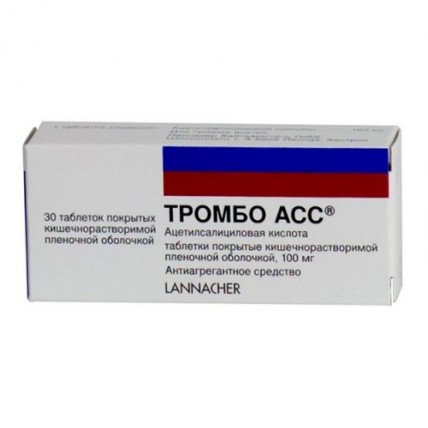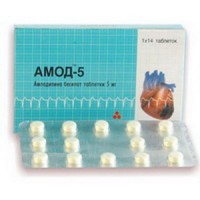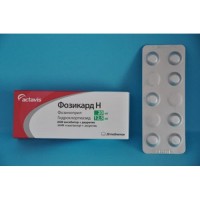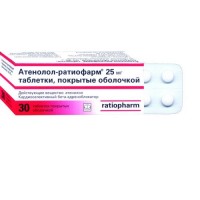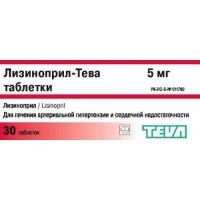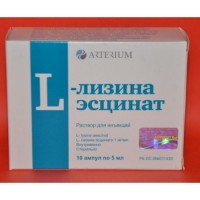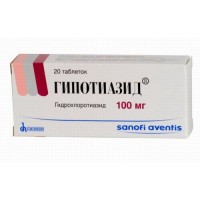Thrombotic 30s ACC 100 mg film-coated tablets solution / intestinal.
- $8.10
The instruction for medical use
of Trombo АСС® medicine
the Trade name
of Trombo of ASS ®
the International unlicensed name
Acetylsalicylic acid
the Dosage form
of the Tablet, covered with a kishechnorastvorimy film cover, 50 mg and
100 mg
Structure
One tablet contains
active agent - acetylsalicylic acid of 50 mg or 100 mg,
excipients: lactoses monohydrate, cellulose microcrystalline, silicon dioxide colloidal, potato starch,
structure of a cover: talc, triacetin, copolymer methacrylic acid – % ethyl acrylate (1:1) 30 dispersiya1.
1 22.63 mg of suspension correspond to 6.79 mg of dry matter (for a dosage of 50 mg)
33.95 mg of suspension correspond to 10.185 mg of dry matter (for a dosage of 100 mg)
the Description
of the Tablet of round shape, with a biconvex surface, coated white color
Pharmacotherapeutic group
Analgetics. Other analgetics-antipyretics. Salicylic acid and its derivatives. Acetylsalicylic acid.
The ATX N02BA01 code
the Pharmacological
Pharmacokinetics At properties use drug is soaked up in a small intestine as has the cover resistant to effect of gastric juice. The maximum levels of drug in plasma are observed in 3 hours after its use.
Under the influence of enzymes, acetylsalicylic acid (ASK) is hydrolyzed on salicylic acid in a liver and partially in mucous a small intestine. Besides, salicylic acid glyukoronizirutsya in a liver. Owing to fermental esterazny activity, concentration of acetylsalicylic acid in plasma quickly falls whereas concentration of the main metabolite - salicylic acid - increases and reaches a maximum in 4 h after administration of drug.
Distribution of acetylsalicylic acid and salicylic acid in fabrics and liquids of an organism is carried out by mainly passive diffusion which depends on the pH level and concentration. Therefore salicylates collect in fabrics with low PH values.
The volume of distribution of salicylates depends on a dose. At the use of low (antitrombotichesky) doses it is about 0.2 l/kg that demonstrates mainly extracellular distribution in connection with high linking with proteins of blood plasma – from 89 to 90%.
The half-life period of acetylsalicylic acid in blood is from 15 to 20 min. Acetylsalicylic acid is exposed to full transformation and therefore it is brought out of an organism only in the form of metabolites with urine. At the use of therapeutic doses of acetylsalicylic acid its primary metabolite – salicylic acid is found in urine mainly in the form of a glycine conjugate (salitsilmochevy acid – 75%) and also in the form of ether and radio glucuronides (from 5 to 10% and as free salicylic acid (10%).
Increase in pH of urine, for example, at bicarbonate infusion, considerably increases removal of salicylates (in 5-10raz).
The pharmacodynamics
Acetylsalicylic acid is non-steroidal anti-inflammatory drug. When assigning low doses (30-300 mg) the main mechanism of effect of acetylsalicylic acid is the cyclooxygenase enzyme inactivation therefore synthesis of prostaglandins, prostacyclins and thromboxane from arachidonic acid is broken. Irreversible disturbance of synthesis of A2 thromboxane in thrombocytes causes antiagregantny effect of acetylsalicylic acid. Besides, acetylsalicylic acid blocks reaction of release of thrombocytes as a result of which a large amount of the substances also capable to cause aggregation of thrombocytes such as ADF (adenosinediphosphate), serotonin, factor of activation of thrombocytes, etc. is distinguished. In doses 30-300mg ASK effectively inhibits a thrombogenesis on the injured endothelium of a vascular wall, preventing growth of platelet blood clot. Thus, the antithrombocytic effect of acetylsalicylic acid directed to prevention and treatment of the diseases connected with the increased aggregation of thrombocytes is shown. Drug improves functions of thrombocytes at patients with cerebral and vascular diseases, diseases of peripheral arteries, coronary heart disease (including a myocardial infarction) and other vascular diseases. Besides, acetylsalicylic acid reduces the phenomena of a thrombembolia and reduces quantity of restenoses at patients (after heart surgeries).
Indications
- primary and secondary prevention of a myocardial infarction at patients with stenocardia
- reduction of risk of a recurrence of a myocardial infarction among patients with coronary heart disease
- prevention of disturbances of cerebral circulation on ischemic type and a stroke
- prevention of thromboses and an embolism, including at patients with the increased risk are their emergence (after heart surgeries and vessels, aortocoronary shunting)
- prevention of cardiovascular pathology in diabetes
the Route of administration and doses
of the Tablet Trombo of ASS covered with a kishechnorastvorimy film cover should be accepted inside, without chewing, washing down with a small amount of liquid in one and too time of day. For maintaining integrity of a film cover the tablet is not recommended to be divided. The recommended dose at above-mentioned indications makes from 50 to 300 mg once a day. It is not required from elderly patients of dose adjustment. Maximum daily dose of 300 mg.
The drug is recommended to be taken it is long in low doses. The dose and duration of treatment are defined by the attending physician.
Side effects
Often
- disturbances from digestive tract (heartburn, nausea, vomiting, pain in epigastriums, diarrhea)
- microbleedings from digestive tract
Sometimes
- bleedings and ulcers of a gastro intestinal path (which symptoms are black the kcal or vomiting blood)
it is rare
- thrombocytopenia, increase in a bleeding time, a leukopenia
- hypersensitivity reactions (bronchospasm, a Quincke's disease, skin manifestations, anaphylactic reactions, a Quincke's edema, a cardiorespiratory distress)
- an asthmatic attack
- disturbances from digestive tract (nausea, vomiting, diarrhea)
- the concealed gastrointestinal hemorrhages capable to lead to an iron deficiency anemia
- lengthening of a menstrual cycle
- provocation of attacks of bronchial asthma
- at long therapy by high doses of drug disturbances from kidneys (hamaturia, a nephropathy, a leukocyturia, an albuminuria) are possible
It is very rare
- a hypoglycemia
- a gout attack
- a headache, dizziness, confusion of consciousness
- decrease in hearing, sonitus
- increase in activity of hepatic transaminases
- a cerebral hemorrhage (especially at patients with uncontrollable arterial hypertension)
Contraindications
- hypersensitivity to salicylic acid and its derivatives or nonsteroid soothing/anti-inflammatory drugs (NPVS), and also to excipients
- a peptic ulcer of digestive tract in an aggravation stage
- hemorrhagic diathesis, thrombocytopenia, hemophilia
- a renal failure and an oksaluriya
- the profound liver failure
- the profound uncontrollable heart failure
- the accompanying reception of a methotrexate in a dose of 15 mg and more in a week
- a prothrombinopenia
- deficit glyukozo-6-fosfatdegidrogenazy
- pregnancy and the period of a lactation
- children's age up to 18 years
- hereditary intolerance of fructose, deficiency of Lapp enzyme – lactase, glucose galactose malabsorption
Medicinal interactions
of Trombo strengthens ASS:
- effect of anticoagulants and antiagregantny drugs (for example, warfarin and other derivatives of coumarin, heparin, Dipiridamolum, Sulfinpyrazonum)
- effect of other inhibitors of aggregation of thrombocytes, for example a tiklopidina, a klopidogrela: increase in a bleeding time
- effect of anti-diabetic drugs – hypoglycemic effect of derivatives of sulphonylurea
- the desired and undesirable effects of nonsteroid anti-inflammatory and antirheumatic drugs
- the desired and undesirable effects of a methotrexate
- risk of gastrointestinal bleeding is possible at simultaneous use with glucocorticoids or alcohol
- concentration of digoxin, barbiturates and lithium in blood plasma
- effect of sulfanamide drugs and combinations of streptocides, including co-trimoxazole
- effect of triiodothyronine
- effect of valproic acid.
Drug weakens:
- action of antagonists of Aldosteronum (Spironolactonum and kanrenon)
- effect of loopback diuretics (for example, furosemide)
- effect of uricosuric drugs (probenetsid, Sulfinpyrazonum)
- effect of APF inhibitors
At a concomitant use of tetracyclines not soaking up complexes can be formed. Thus, between intake of these drugs it is necessary to observe an interval of not less than 1-3 hours.
It is necessary to be careful at the accompanying intake of cyclosporine or a takrolimus.
In need of complex use of Trombo of ASS and above-mentioned drugs the interval between them has to make not less than 1-3 hours.
ASS should appoint special instructions of Trombo with care in the following cases:
- anamnestic data on hypersensitivity reactions on use of NPVS
- bronchial asthma, hay fever, a rhinedema, chronic diseases of respiratory organs
- the accompanying therapy by anticoagulants (coumarin derivatives, heparin, except for the low-dosed therapy by heparin)
- erosive and ulcer and inflammatory diseases of digestive tract out of aggravation
- functional disturbances from a liver or kidneys
Before holding surgical procedures (even before insignificant interventions, such as dental operation) need to be reported to the doctor about reception of the tablets Trombo of ASS, film coated and to consider antiagregantny effect of acetylsalicylic acid. Increase in a bleeding time is possible.
It is necessary to avoid additional intake of other salicylates or nonsteroid anti-inflammatory/antirheumatic drugs.
In case of reception of high doses of drug within several years the development of a renal failure is possible. It is necessary to control function of kidneys periodically.
Patients who appointed thrombolytic therapy are recommended to be examined on presence of symptoms of external or internal bleeding (for example, hematomas).
In low doses acetylsalicylic acid reduces removal of uric acid that can cause gout attacks in predisposed patients.
Drug contains lactose monohydrate. Patients with rare hereditary problems of intolerance of a galactose, deficiency of Lappa lactase or a sprue of glucose and a galactose are not recommended to take this drug.
Whether features of influence of medicine on ability to run the vehicle potentially dangerous mechanisms.
Considering a possibility of development of such side effects as dizziness, confusion of consciousness whether it is necessary to be careful when driving by potentially dangerous mechanisms.
Overdose
As a rule, it is necessary to distinguish the chronic overdose by acetylsalicylic acid which is followed by disturbances mainly from nervous system, such as drowsiness, dizziness, confusion of consciousness or nausea (poisoning with salicylic acid or its connections), and acute poisoning.
Symptoms of acute poisoning: heavy disturbance of acid-base balance. Even at therapeutic doses there can be a respiratory alkalosis against the background of rapid breathing. It is compensated by the raised hydrocarbonate discharge kidneys therefore pH of blood remains in the normal range of values. At toxic doses such compensation is insufficient therefore pH of blood and concentration of a hydrocarbonate decrease. PCO2 values of blood can remain normal. External signs indicate a clinical picture of a metabolic acidosis. Actually such manifestations are a combination of a respiratory and metabolic acidosis which reasons are: the breath disturbance caused by toxic doses, acid cumulation, partially because of the lowered renal excretion (sulphuric and phosphoric acid and also salicylic, lactic, acetoacetic acid, etc.) caused by disturbance of carbohydrate metabolism. Besides, the electrolytic balance is broken and there is an extensive loss of potassium.
Acute poisoning of easy or moderate degree (200-400 mkg/ml): disturbance of acid-base balance, disturbance of electrolytic balance (for example, potassium loss), a hypoglycemia, rash on skin, gastrointestinal bleeding, a hyperventilation, sonitus, nausea, vomiting, disorders of vision and hearing, a headache, dizziness and confusion of consciousness is possible.
Serious poisoning (more than 400 mkg/ml): development of delirium, a tremor, asthma, the increased sweating, an eksikoza, a hyperthermia and a coma is possible.
Lethal poisonings: death usually is caused by an apnoea.
Treatment: the choice of treatment in poisoning with acetylsalicylic acid is based on weight, a stage and clinical symptoms of poisoning. As therapy take usual measures for decrease in absorption of active agent, control of water and electrolytic balance and also normalization of the broken thermal control and breath.
The priority has to be given to the measures contributing to removal and normalization of acid-base and electrolytic balance. Besides intravenous administration of solutions of bicarbonate and potassium of chloride, it is possible to appoint diuretics. Urine has to be alkaline for increase in extent of ionization of salicylates and decrease in a canalicular reabsorption.
Control of pH of blood, an indicator of pCO2, level of a hydrocarbonate, potassium, etc. is recommended. In hard cases the intensive care (the forced alkaline diuresis, a hemodialysis), intake of diazepam in spasms can be required.
The form of release and packing
On 10 or 20 tablets place in blister strip packaging from a film of the polyvinylchloride and printing aluminum foil varnished.
On 3 planimetric packs (on 10 tablets) or 5 planimetric packs (on 20 tablets) together with the instruction for medical use in the state and Russian languages place in a pack from cardboard.
To Store storage conditions in the dry, protected from light place, at a temperature not above 25 °C.
To store out of children's reach!
A period of storage
3 years
not to use drug after expiry date.
Prescription status
Without prescription
the Producer
"G.L. Pharma GmbH.", Industriestraße 1, A-8502 Lannach, Austria
the Owner of the registration certificate
of OOO "Valeant", Moscow, Russia
the Address of the organization accepting in the territory of the Republic of Kazakhstan claims from consumers on quality of products
Representative office of OOO "Valeant" in RK
Kazakhstan,
050059, Almaty, Al-Farabi Avenue, 17, Block 4B, room 4-4B-11
Phone number 3 111 516 Fax 3 111 517
Eletronnaya Develop mail Office.KZ@valeant.com
of Trombo АСС® medicine
the Trade name
of Trombo of ASS ®
the International unlicensed name
Acetylsalicylic acid
the Dosage form
of the Tablet, covered with a kishechnorastvorimy film cover, 50 mg and
100 mg
Structure
One tablet contains
active agent - acetylsalicylic acid of 50 mg or 100 mg,
excipients: lactoses monohydrate, cellulose microcrystalline, silicon dioxide colloidal, potato starch,
structure of a cover: talc, triacetin, copolymer methacrylic acid – % ethyl acrylate (1:1) 30 dispersiya1.
1 22.63 mg of suspension correspond to 6.79 mg of dry matter (for a dosage of 50 mg)
33.95 mg of suspension correspond to 10.185 mg of dry matter (for a dosage of 100 mg)
the Description
of the Tablet of round shape, with a biconvex surface, coated white color
Pharmacotherapeutic group
Analgetics. Other analgetics-antipyretics. Salicylic acid and its derivatives. Acetylsalicylic acid.
The ATX N02BA01 code
the Pharmacological
Pharmacokinetics At properties use drug is soaked up in a small intestine as has the cover resistant to effect of gastric juice. The maximum levels of drug in plasma are observed in 3 hours after its use.
Under the influence of enzymes, acetylsalicylic acid (ASK) is hydrolyzed on salicylic acid in a liver and partially in mucous a small intestine. Besides, salicylic acid glyukoronizirutsya in a liver. Owing to fermental esterazny activity, concentration of acetylsalicylic acid in plasma quickly falls whereas concentration of the main metabolite - salicylic acid - increases and reaches a maximum in 4 h after administration of drug.
Distribution of acetylsalicylic acid and salicylic acid in fabrics and liquids of an organism is carried out by mainly passive diffusion which depends on the pH level and concentration. Therefore salicylates collect in fabrics with low PH values.
The volume of distribution of salicylates depends on a dose. At the use of low (antitrombotichesky) doses it is about 0.2 l/kg that demonstrates mainly extracellular distribution in connection with high linking with proteins of blood plasma – from 89 to 90%.
The half-life period of acetylsalicylic acid in blood is from 15 to 20 min. Acetylsalicylic acid is exposed to full transformation and therefore it is brought out of an organism only in the form of metabolites with urine. At the use of therapeutic doses of acetylsalicylic acid its primary metabolite – salicylic acid is found in urine mainly in the form of a glycine conjugate (salitsilmochevy acid – 75%) and also in the form of ether and radio glucuronides (from 5 to 10% and as free salicylic acid (10%).
Increase in pH of urine, for example, at bicarbonate infusion, considerably increases removal of salicylates (in 5-10raz).
The pharmacodynamics
Acetylsalicylic acid is non-steroidal anti-inflammatory drug. When assigning low doses (30-300 mg) the main mechanism of effect of acetylsalicylic acid is the cyclooxygenase enzyme inactivation therefore synthesis of prostaglandins, prostacyclins and thromboxane from arachidonic acid is broken. Irreversible disturbance of synthesis of A2 thromboxane in thrombocytes causes antiagregantny effect of acetylsalicylic acid. Besides, acetylsalicylic acid blocks reaction of release of thrombocytes as a result of which a large amount of the substances also capable to cause aggregation of thrombocytes such as ADF (adenosinediphosphate), serotonin, factor of activation of thrombocytes, etc. is distinguished. In doses 30-300mg ASK effectively inhibits a thrombogenesis on the injured endothelium of a vascular wall, preventing growth of platelet blood clot. Thus, the antithrombocytic effect of acetylsalicylic acid directed to prevention and treatment of the diseases connected with the increased aggregation of thrombocytes is shown. Drug improves functions of thrombocytes at patients with cerebral and vascular diseases, diseases of peripheral arteries, coronary heart disease (including a myocardial infarction) and other vascular diseases. Besides, acetylsalicylic acid reduces the phenomena of a thrombembolia and reduces quantity of restenoses at patients (after heart surgeries).
Indications
- primary and secondary prevention of a myocardial infarction at patients with stenocardia
- reduction of risk of a recurrence of a myocardial infarction among patients with coronary heart disease
- prevention of disturbances of cerebral circulation on ischemic type and a stroke
- prevention of thromboses and an embolism, including at patients with the increased risk are their emergence (after heart surgeries and vessels, aortocoronary shunting)
- prevention of cardiovascular pathology in diabetes
the Route of administration and doses
of the Tablet Trombo of ASS covered with a kishechnorastvorimy film cover should be accepted inside, without chewing, washing down with a small amount of liquid in one and too time of day. For maintaining integrity of a film cover the tablet is not recommended to be divided. The recommended dose at above-mentioned indications makes from 50 to 300 mg once a day. It is not required from elderly patients of dose adjustment. Maximum daily dose of 300 mg.
The drug is recommended to be taken it is long in low doses. The dose and duration of treatment are defined by the attending physician.
Side effects
Often
- disturbances from digestive tract (heartburn, nausea, vomiting, pain in epigastriums, diarrhea)
- microbleedings from digestive tract
Sometimes
- bleedings and ulcers of a gastro intestinal path (which symptoms are black the kcal or vomiting blood)
it is rare
- thrombocytopenia, increase in a bleeding time, a leukopenia
- hypersensitivity reactions (bronchospasm, a Quincke's disease, skin manifestations, anaphylactic reactions, a Quincke's edema, a cardiorespiratory distress)
- an asthmatic attack
- disturbances from digestive tract (nausea, vomiting, diarrhea)
- the concealed gastrointestinal hemorrhages capable to lead to an iron deficiency anemia
- lengthening of a menstrual cycle
- provocation of attacks of bronchial asthma
- at long therapy by high doses of drug disturbances from kidneys (hamaturia, a nephropathy, a leukocyturia, an albuminuria) are possible
It is very rare
- a hypoglycemia
- a gout attack
- a headache, dizziness, confusion of consciousness
- decrease in hearing, sonitus
- increase in activity of hepatic transaminases
- a cerebral hemorrhage (especially at patients with uncontrollable arterial hypertension)
Contraindications
- hypersensitivity to salicylic acid and its derivatives or nonsteroid soothing/anti-inflammatory drugs (NPVS), and also to excipients
- a peptic ulcer of digestive tract in an aggravation stage
- hemorrhagic diathesis, thrombocytopenia, hemophilia
- a renal failure and an oksaluriya
- the profound liver failure
- the profound uncontrollable heart failure
- the accompanying reception of a methotrexate in a dose of 15 mg and more in a week
- a prothrombinopenia
- deficit glyukozo-6-fosfatdegidrogenazy
- pregnancy and the period of a lactation
- children's age up to 18 years
- hereditary intolerance of fructose, deficiency of Lapp enzyme – lactase, glucose galactose malabsorption
Medicinal interactions
of Trombo strengthens ASS:
- effect of anticoagulants and antiagregantny drugs (for example, warfarin and other derivatives of coumarin, heparin, Dipiridamolum, Sulfinpyrazonum)
- effect of other inhibitors of aggregation of thrombocytes, for example a tiklopidina, a klopidogrela: increase in a bleeding time
- effect of anti-diabetic drugs – hypoglycemic effect of derivatives of sulphonylurea
- the desired and undesirable effects of nonsteroid anti-inflammatory and antirheumatic drugs
- the desired and undesirable effects of a methotrexate
- risk of gastrointestinal bleeding is possible at simultaneous use with glucocorticoids or alcohol
- concentration of digoxin, barbiturates and lithium in blood plasma
- effect of sulfanamide drugs and combinations of streptocides, including co-trimoxazole
- effect of triiodothyronine
- effect of valproic acid.
Drug weakens:
- action of antagonists of Aldosteronum (Spironolactonum and kanrenon)
- effect of loopback diuretics (for example, furosemide)
- effect of uricosuric drugs (probenetsid, Sulfinpyrazonum)
- effect of APF inhibitors
At a concomitant use of tetracyclines not soaking up complexes can be formed. Thus, between intake of these drugs it is necessary to observe an interval of not less than 1-3 hours.
It is necessary to be careful at the accompanying intake of cyclosporine or a takrolimus.
In need of complex use of Trombo of ASS and above-mentioned drugs the interval between them has to make not less than 1-3 hours.
ASS should appoint special instructions of Trombo with care in the following cases:
- anamnestic data on hypersensitivity reactions on use of NPVS
- bronchial asthma, hay fever, a rhinedema, chronic diseases of respiratory organs
- the accompanying therapy by anticoagulants (coumarin derivatives, heparin, except for the low-dosed therapy by heparin)
- erosive and ulcer and inflammatory diseases of digestive tract out of aggravation
- functional disturbances from a liver or kidneys
Before holding surgical procedures (even before insignificant interventions, such as dental operation) need to be reported to the doctor about reception of the tablets Trombo of ASS, film coated and to consider antiagregantny effect of acetylsalicylic acid. Increase in a bleeding time is possible.
It is necessary to avoid additional intake of other salicylates or nonsteroid anti-inflammatory/antirheumatic drugs.
In case of reception of high doses of drug within several years the development of a renal failure is possible. It is necessary to control function of kidneys periodically.
Patients who appointed thrombolytic therapy are recommended to be examined on presence of symptoms of external or internal bleeding (for example, hematomas).
In low doses acetylsalicylic acid reduces removal of uric acid that can cause gout attacks in predisposed patients.
Drug contains lactose monohydrate. Patients with rare hereditary problems of intolerance of a galactose, deficiency of Lappa lactase or a sprue of glucose and a galactose are not recommended to take this drug.
Whether features of influence of medicine on ability to run the vehicle potentially dangerous mechanisms.
Considering a possibility of development of such side effects as dizziness, confusion of consciousness whether it is necessary to be careful when driving by potentially dangerous mechanisms.
Overdose
As a rule, it is necessary to distinguish the chronic overdose by acetylsalicylic acid which is followed by disturbances mainly from nervous system, such as drowsiness, dizziness, confusion of consciousness or nausea (poisoning with salicylic acid or its connections), and acute poisoning.
Symptoms of acute poisoning: heavy disturbance of acid-base balance. Even at therapeutic doses there can be a respiratory alkalosis against the background of rapid breathing. It is compensated by the raised hydrocarbonate discharge kidneys therefore pH of blood remains in the normal range of values. At toxic doses such compensation is insufficient therefore pH of blood and concentration of a hydrocarbonate decrease. PCO2 values of blood can remain normal. External signs indicate a clinical picture of a metabolic acidosis. Actually such manifestations are a combination of a respiratory and metabolic acidosis which reasons are: the breath disturbance caused by toxic doses, acid cumulation, partially because of the lowered renal excretion (sulphuric and phosphoric acid and also salicylic, lactic, acetoacetic acid, etc.) caused by disturbance of carbohydrate metabolism. Besides, the electrolytic balance is broken and there is an extensive loss of potassium.
Acute poisoning of easy or moderate degree (200-400 mkg/ml): disturbance of acid-base balance, disturbance of electrolytic balance (for example, potassium loss), a hypoglycemia, rash on skin, gastrointestinal bleeding, a hyperventilation, sonitus, nausea, vomiting, disorders of vision and hearing, a headache, dizziness and confusion of consciousness is possible.
Serious poisoning (more than 400 mkg/ml): development of delirium, a tremor, asthma, the increased sweating, an eksikoza, a hyperthermia and a coma is possible.
Lethal poisonings: death usually is caused by an apnoea.
Treatment: the choice of treatment in poisoning with acetylsalicylic acid is based on weight, a stage and clinical symptoms of poisoning. As therapy take usual measures for decrease in absorption of active agent, control of water and electrolytic balance and also normalization of the broken thermal control and breath.
The priority has to be given to the measures contributing to removal and normalization of acid-base and electrolytic balance. Besides intravenous administration of solutions of bicarbonate and potassium of chloride, it is possible to appoint diuretics. Urine has to be alkaline for increase in extent of ionization of salicylates and decrease in a canalicular reabsorption.
Control of pH of blood, an indicator of pCO2, level of a hydrocarbonate, potassium, etc. is recommended. In hard cases the intensive care (the forced alkaline diuresis, a hemodialysis), intake of diazepam in spasms can be required.
The form of release and packing
On 10 or 20 tablets place in blister strip packaging from a film of the polyvinylchloride and printing aluminum foil varnished.
On 3 planimetric packs (on 10 tablets) or 5 planimetric packs (on 20 tablets) together with the instruction for medical use in the state and Russian languages place in a pack from cardboard.
To Store storage conditions in the dry, protected from light place, at a temperature not above 25 °C.
To store out of children's reach!
A period of storage
3 years
not to use drug after expiry date.
Prescription status
Without prescription
the Producer
"G.L. Pharma GmbH.", Industriestraße 1, A-8502 Lannach, Austria
the Owner of the registration certificate
of OOO "Valeant", Moscow, Russia
the Address of the organization accepting in the territory of the Republic of Kazakhstan claims from consumers on quality of products
Representative office of OOO "Valeant" in RK
Kazakhstan,
050059, Almaty, Al-Farabi Avenue, 17, Block 4B, room 4-4B-11
Phone number 3 111 516 Fax 3 111 517
Eletronnaya Develop mail Office.KZ@valeant.com
